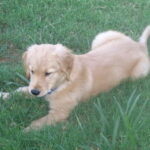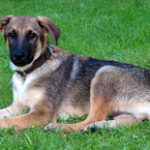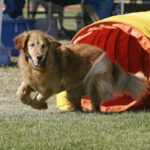Entropion is a common eye condition in which the lower eyelid edges of one or both eyes roll inward. The abnormal position of the eyelid causes the eyelashes to rub against the eyeball, leading to chronic irritation and damage to the cornea. In some cases, the upper eyelid will also be involved.
While it can occur in any dog breed, the most common ones are Chesapeake Bay Retriever, Chow Chow, Collie, English Bulldog, Golden Retriever, Great Dane, Irish Setter, Labrador Retriever, Poodle, Rottweiler, Saint Bernard, Shar-Pei, and the various types of spaniels.
Causes
In the Shar-Pei and Chow Chow, the weight of the folds around the eyes is often the cause of entropion. In other breeds, it is usually due to improper development of the muscles in the eyelid.
Entropion is considered an inherited trait in purebred dogs. If the dog has inherited the trait, it will generally begin to develop the condition within the first few months after birth. Any dog that currently has or has been treated for entropion should not be used for breeding.
Some dogs will develop entropion later in life, usually due to other eye conditions. In these cases, it is often caused by spasms from painful eye diseases, eye injuries or infections.
Symptoms
Most dogs with entropion will have reddened and inflamed eyes. They may squint or scratch at their eyes due to the pain. Other symptoms include excessive tearing, wetness around the eye, thick discharge, and vision problems.
A major concern with entropion is damage to the cornea from the eyelid and eyelashes wearing away its surface. The eye may begin to develop scar tissue to protect itself from the constant abrasion. Scratches and ulcers in the cornea can occur, in some cases going deep enough to rupture the surface. This can lead to serious infections and blindness.
Diagnosis
Diagnosis is made through an examination of the eye. The veterinarian will look at the eyelid position to determine if it is tilted inward. Tests using dye are sometimes done to ascertain how much damage has been done to the cornea. If the damage is severe, or if the veterinarian is not comfortable dealing with the condition, the pet may be referred to a veterinary ophthalmologist.
Treatment
Surgery is the normal treatment for entropion. The most common procedure is to make a small incision, remove a portion of the eyelid, and then suture the two sides of the incision together. This has the effect of tightening the eyelid and pulling it into proper position.
Most cases of entropion can be resolved with a single surgery. If there is doubt as to how much of the eyelid needs to be removed, many veterinarians will err on the side of caution and remove too little to avoid a complication where the eyelid becomes too tight and begins to roll outward. When this decision is made, a second surgery may be required to correct the condition fully. It will take 3 to 4 weeks for the eyelid muscles to heal and strengthen enough to tell if the surgery has been successful.
Puppies under the age of 6 months will often have a procedure called ‘lid tacking’ done instead of surgery. In this procedure, temporary sutures are placed in the lid to pull it back into position. This is usually enough to help strengthen the muscles and give the dog time to mature into its proper facial proportions.
Home care after surgery generally involves applying topical antibiotics or other medications to help heal the cornea. The owner will need to watch the dog for any signs of irritation or infection and prevent the animal from scratching at its eyes. The veterinarian will typically want to recheck the dog 10 to 14 days after surgery to make sure healing is progressing well and to remove the sutures.




